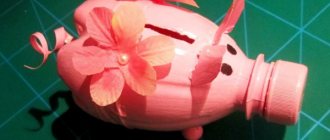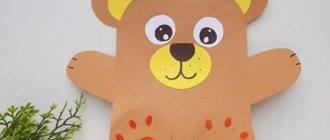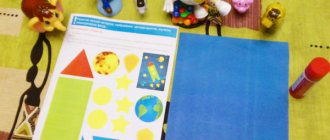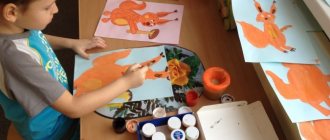LiveInternetLiveInternet
Summary of the final lesson on the formation of elementary mathematical concepts with children 4-5 years old in middle group No. 1 Compiled by: Gubanova S.V., teacher at the Municipal Preschool Educational Institution “Kindergarten No. 78”, 2007
Topic: Matroskin's riddles
Program content:
1. consolidate the ability to count in order, answer the questions: which?, which?;
2. practice comparing objects by length, width, thickness, height: reflecting these features in speech;
3. continue to develop the ability to navigate in time, to know what is happening in a certain period of time (morning, evening, day, night);
4. consolidate knowledge about geometric shapes through the game “Find your house”;
Preliminary work: Classes on REMP, conducting didactic games, individual work in free activity.
Methods and techniques: Game - character introduction, didactic games, outdoor games; verbal – explanation, posing problematic questions; visual - attributes.
Equipment: Fruit basket; 3 ribbons of different lengths and colors; 3 boxes of the same length but different widths; 3 pencils of different thicknesses: thick, thin, thinnest; 3 pyramids of different heights; ball; 4 hoops; geometric shapes: squares – 7 pcs., circles – 7 pcs., rectangles – 7 pcs., triangles – 7 pcs.
Progress of the lesson
The cat Matroskin comes to visit, with a basket in his hands, says hello, and says that he brought gifts for the children, but in order to receive them, you need to guess all of Matroskin’s riddles.
Children sitting at the table
— There are fruits in this basket. Name them and say how many there are.
Questions:
What number is the orange? banana?
Then I invite the children to close their eyes, swap the fruits, when the children open their eyes, I ask:
- Which one is orange now? banana?
Matroskin praises the children and says that they will receive these fruits as a gift if they solve the rest of his riddles. Offers to play the game “Guess what’s missing?” . (children move to the carpet).
On the carpet are: 3 ribbons of different lengths, 3 boxes of different widths, 3 pencils of different thicknesses, 3 pyramids of different heights.
Rules of the game:
The guys close their eyes, at this moment I remove one object. It is necessary to say what is missing and to characterize this object. (For example, the shortest tape was removed).
Matroskin praises the children and invites them to play a game.
Physical school
Matroskin: And now I want to know if the guys know the parts of the day? Here is a magic ball, you need to catch it and answer the question.
(children stand on the carpet in a circle)
Questions:
— When do you have breakfast?
— When does your mother come to pick you up at kindergarten?
- It’s dark outside, do you make your bed and go to bed when?
— When do we have lunch in the kindergarten?
Matroskin praises the children and offers a new game “Find Your Place”
Rules of the game:
Take any geometric shape from the tray. According to the music, you move throughout the group, and when it ends, you must stand at the hoop where your geometric figure lies. The team that lines up next to its hoop first wins.
Matroskin sums it up; says who showed his worth and in what game; asks what the kids liked and gives fruit as a gift.
The lesson is over.
MAGAZINE Preschooler.RF
Abstract of the GCD “Break application” - “Porcini mushroom” in the middle groupGoal: to introduce children to a new technique of working with paper: tearing, performing work using the tearing appliqué technique.
Tasks:
Educational:
- introduce children to the technique of cut appliqué
- master the technique of cut appliqué
- expand children's knowledge about various methods of appliqué
Educational:
- develop children's imagination
- develop fine motor skills of hands
- develop interest in artistic creativity
- develop observation, memory, imagination, attention, logical thinking.
Educational:
- continue to develop emotional responsiveness in children
- cultivate interest in nature and aesthetic feelings.
Equipment and materials for carrying out GCD:
- cardboard with an outline image of a mushroom
- colored paper:
- brown (mushroom cap)
- beige (mushroom stem)
- green grass)
- glue
- glue brushes
- oilcloth - lining
Conducting GCD:
Organizational stage
Educator: - Hello children.
Children: - Say hello
Educator: Guys, this morning I met a forest dweller near the kindergarten. Want to know which one?
Children: Yes
Educator: then guess the riddle: “Under the pines, under the fir trees there lies a bag of needles . (Hedgehog)
Educator: That's right, well done.
Educator: The hedgehog told me a very sad story, he didn’t notice at all how autumn had come, but after autumn the cold season of the year, winter, will come. All the inhabitants of the forest have been collecting berries and mushrooms for a long time, but he has not collected anything. So a hedgehog came to our kindergarten to ask the children to help him collect mushrooms for his family, which they really like to eat in winter.
Educator: Guys, do you agree to help the hedgehog?
Children: Yes
Educator: Well then, today we will go to the forest where the hedgehog lives and we will collect only edible mushrooms, namely the white mushroom, because the white mushroom is the largest mushroom in the forest.
Physical education minute:
Kolya walked and walked and walked and found a porcini mushroom. One - fungus Two - fungus
Three - fungus, I put them in the box.
We looked at everything around us, there are no mushrooms anywhere anymore
And everyone sat down quietly. The teacher reads a poem, and the children imitate the movements of a mushroom picker: they walk,
bend down and put the mushrooms in the box.
Educator: Guys, look at what parts does the porcini mushroom consist of?
Children name the parts of the mushroom (leg, cap)
Educator: Well done.
The teacher shows pictures of mushrooms and an application with the image of a mushroom (ceps).
Children: Looking at pictures
Educator: Today we will make a mushroom (ceps)
To produce our works, we will use a very interesting and unusual type of applique: “Break applique”
You and I will not cut the paper, but tear it off, that’s why it’s called “BREAKING”.
Let's repeat it again:
Tear applique is obtained because we tear the paper and do not cut it with scissors.
Educator: Children, there is cardboard in front of you, and what do you see on the cardboard?
Children: Image of a mushroom.
Educator:
That's right - this is the outline of our mushroom. You also have colored paper on your table - brown, beige and green.
Educator: The paper needs to be torn into small pieces to design our application.
And now we will prepare our fingers for work.
Finger gymnastics “Mushrooms”
Amanita muscaria is a dangerous mushroom Children threaten with their index finger
And the second is a fox, a red-haired sister. Children extend their fingers one by one.
Third fungus mushroom, pink ear
And the fourth mushroom is the bearded old man morel
The fifth mushroom is white
Eat it with confidence!
Educator: Well done! We are ready to get to work.
Educator: First, you need to tear up pieces of paper.
We will tear off small pieces of brown paper from a sheet of paper, then beige and green.
Pieces of paper should be placed in different plates:
- brown (mushroom cap)
- beige (mushroom stem)
- green (grass)
Before we begin, we must review the safety rules when working with glue.
Next stage: Gradually fill in the silhouette of the mushroom with colored pieces.
Apply glue to the silhouette of the mushroom and gradually fill in the inner contours of the mushroom pattern (brown for the cap, beige for the stem, green for the grass) in a mosaic style.
Educator: What beautiful work you have done!
The work was done neatly and beautifully.
Hedgehog: Guys, what big porcini mushrooms you managed to find and make for my whole family. Thank you very much, now we will be full all winter.
Educator: Guys, what a great fellow we are, how many mushrooms we collected today. What mushrooms were we looking for for the hedgehog today?
Children: porcini mushrooms
Educator: Our porcini mushrooms are enough for the winter not only for the hedgehog’s family, but also for all the animals in the forest, let’s take the mushrooms to the clearing.
Children and the teacher organize an exhibition in the group or reception area.
Educator: This concludes our lesson.
| Next > |
School age children
Junior grades are able to independently separate details according to a model, and can assemble a complete picture, focusing on their imagination. Initially, you should show the children what the finished craft will look like.
To work you will need brushes, colored paper, glue, scissors, cardboard, a ruler and a simple pencil.
A base is prepared, geometric shapes in a specific theme are sketched on it. All details are copied from the base, cut out and glued according to the template.
Typewriter
When working with a child, it is important to take into account his interests; for example, a boy will be much more interested in assembling a craft in the form of a car. The application will be appreciated by children aged 3-5 years, and for the work you will need colored paper, glue, a simple pencil, scissors and a model of the machine.
Stages of work:
- Shapes are cut out - rectangles for the body, circles for the wheels. You can complement the picture with smoke from ovals, and a route from a black elongated rectangle. Details are added or removed based on the child’s characteristics; if the baby is diligent and easily involved in the task, then you can freely supplement the composition. Don’t forget about the brightness of color, it is what makes the creative process even more interesting.
- Each element is smeared with glue in turn and glued to the background. The road and body come first, and then the wheels and smoke.
For greater expressiveness, you can draw trees, the sun and clouds with colored pencils. Blue color is ideal for a base. In a more complex version, the child himself cuts out the parts along the marked lines.








